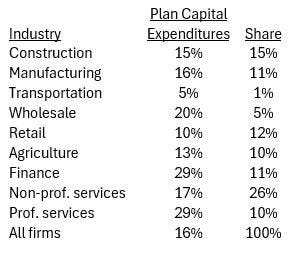In January 2025, more small business owners found conditions more favorable for business expansion, with 17% declaring the current period as a good time for small businesses to expand substantially, up from 4% last September. Of those who think it is a good time to expand, 26% are providers of non-professional services and 15% are in the construction industry.
The improvement in expected business conditions also triggered the “animal spirits” of small business owners, many of whom started their firms with the hope and expectation of growing larger (look out Amazon!). The percent of owners anticipating more supportive business conditions rose from net -12% (more expected worse than expected better conditions) to net 47%, a 59-percentage point improvement.
Expansion means spending, “investing” in plant and equipment and training. Overall, the percent of firms planning on making capital outlays rose from 17% last September to 28% in November and December, easing to 21% in January this year. Table 1 shows the percent of owners in each industry group planning to spend, and the share of the total number of firms planning to spend accounted for by each industry group. Professional services and financial services led the parade with 29% of the firms planning outlays. Of all firms with plans, non-professional services accounted for the largest share of spenders (26%), followed by construction (15%).
In January, 56% reported capital outlays in the last six months. Unions are demanding job protection from innovation including AI, but only 6% of the private sector workforce is unionized (33% in the public sector) so progress on productivity enhancement depends on the non-union private sector employers and owners’ investments in new technologies. Investments can directly or indirectly increase output per hour of work, the key to improved compensation. Even simple investments (like better shovels) can raise productivity. Improved surroundings can as well (better air quality, appearance, or more comfort). Forty-one percent invested in new equipment and 16% improved facilities.
With nearly half of our GDP produced by small firms (under 500 employees, SBA), policies set by Congress and implemented by various agencies will shape the investment environment and determine how much productive capital is added and its impact on worker productivity and compensation.
Read the full article here

